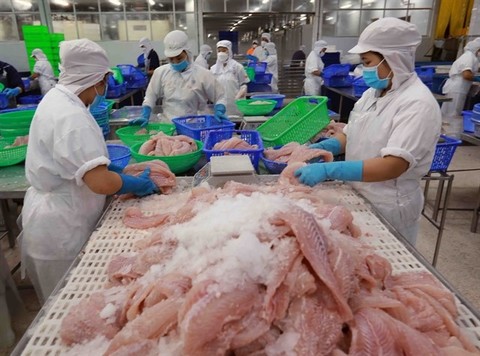
A tra fish processing plant in Đồng Tháp Province. Việt Nam’s exports of many types of seafood products recorded positive growth in April. — VNA Photo
Việt Nam’s seafood exports during the first four months of the year reached US$2.7 billion, up 6 per cent, with exports of many products seeing positive growth in April.
According to the Việt Nam Association of Seafood Exporters and Producers (VASEP), the country’s seafood exports in April reached $700 million, up 4 per cent year-on-year.
Shrimp exports were in April were similar to that of the same month last year at around $285 million, the highest amount since the start of the year.
According to businesses, shrimp exports are recovering as the inventory stocks are falling and need to be refilled, but actual consumer demand has not shown signs of growth.
Average export prices are still lower than two years ago.
The US is considering recognising Việt Nam as having a market economy status, which is expected to remove the trade barrier of anti-subsidy taxes, which would help Vietnamese shrimp exporters.
Lê Hằng, communications director of VASEP, said that tra fish exports in April reached $168 million, up 13 per cent, which is a positive sign after tra fish exports dropped in February and March.
Exports to the US market are seeing positive signs after Vietnamese tra fish businesses partook in the Seafood Expo North America in Boston in March, she said, adding that they also participated in Spain’s Seafood Expo Global in April.
In addition to frozen tra fish fillet, they focused on promoting deep processed catfish products with high added value, garnering the attention of importers and visitors at the exhibitions.
Tuna exports in April were up 28 per cent, exports of squid and octopus were down 14 per cent, and shelled mollusks were up 14 per cent.
Lê Hằng said that Việt Nam’s tuna, squid, octopus and sea fish processing industries are all facing the shortage of raw materials. Domestic supply is not enough to fulfill demand, so they have to import from other countries.
Regulations from the EU and Việt Nam’s new regulations to tackle illegal, unreported and irregular fishing are further hindering local supply.
For example, Vietnamese importers are now expected to notify and declare documents 72 hours before docking for foreign ships or 48 hours for container ships, which many consider to be unreasonable.
They are also unclear about a new regulation on how exporters cannot “mix together” raw seafood materials that are imported with raw seafood materials that are harvested domestically in the same batch of exported goods.
Meanwhile, exports of crab in April surged 101 per cent, with China being the main market and live crab being the key product. Other products have strong potential in China due to its close location to Việt Nam, such as live lobster and sea cucumber.
Among the top five largest export markets of Việt Nam, Japan and Korea saw slight growth in seafood imports, while the others remained the same or even fell.
Exports to China have been dropping since February, as the country has many suppliers to choose from, with competitive prices.
According to seafood exporters, if the challenges surrounding importing raw seafood materials are alleviated, exports during the second half of the year will be more favourable. — VNS